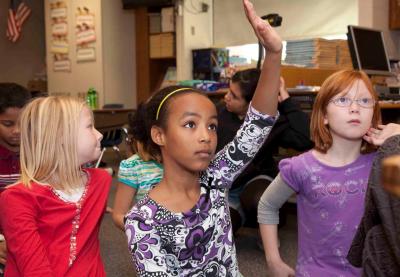History can seem nebulous and distant to anyone, let alone someone who’s only been alive for six years. But the necessity of addressing the history of the civil rights movement with young kids is, on the whole, pretty uncontroversial. Due to his legacy of steadfast courage, peaceful organizing and nonviolent resistance, Dr. Martin Luther King, Jr. is often used to introduce students to the movement. Children may be exposed to a sanitized version of his work, but they rightly understand that he shattered incredible barriers.
Yet, despite evident connections between the work of Dr. King and the work of today’s civil rights activists, too often educators fail to trace throughlines for students. We need to stop avoiding this critical conversation with our young students and make space for them to draw those connections. Dr. Martin Luther King, Jr. Day is a great opportunity to do so.
First-graders are excited to study through a lens of fairness; it is largely what drives them in their daily interactions. If they can understand why Dr. King marched, then they can certainly wrap their minds around the need for continued protest and action in the face of ongoing systemic injustice. When I teach the history of the civil rights movement, I tell my students that, yes, Dr. King was killed for what he believed, but his cause never truly ended. Working together, we identify Dr. King’s principles and link them to the world we live in. Then students are ready to bear closer witness to the activism of focused, courageous black people and their allies today.
The children I teach are open-minded truth-seekers who love to question, probe, absorb and engage wholeheartedly with issues of inequity; tackling injustice fires them up and makes them excited to solve problems together. What tends to be tricky is making the cross-generational connection explicit and developmentally appropriate. This is what I’ve been exploring with my class since the Black Lives Matter (BLM) hashtag made its first appearance in 2013.
What I’ve found is that young students are not only capable of understanding why BLM is necessary through a historical lens, but also they are developmentally primed to ask difficult questions, generate thought-provoking insights and wrestle openly and unambiguously with difficult themes. There is much in the way of content and methodology that is accessible to young kids; resources are increasingly easy to find. In my class, we’ve made our own BLM posters, explored the Oakland roots of BLM co-founder Alicia Garza, read relevant children’s literature, and observed and discussed the related work being done by our middle and high schoolers and the Black Student Union.
As with so much of our first-grade curriculum and practice, bringing these weighty discussions down to a hyper-local level has proven crucial. Last year around MLK Day, we compared the guiding principles of Black Lives Matter to our school’s mission and, even closer to home, our classroom charter. We found much in common, particularly BLM’s focus on diversity, empathy and loving engagement, and its overt ties to feminism and gender identity issues.
During the handful of years I’ve worked with kids on tying BLM to the civil rights movement, the responses from students have been thoughtful, incisive and challenging. To the guiding question “Why is a movement still needed today?” one child flatly answered: “Because people with black and brown skin are still treated badly.” Another remarked that “things are better now, but we’ve only ever had one black president and now he’s gone.”
An entire discussion arose from a student’s observation that “mattering” is the same thing as “just being loved for who you are,” and together we came to the conclusion that realizing you may not matter is one of the worst feelings there is. Unencumbered by adult filters, kids ask the tough questions: “Why do the police hurt Black people?” “What good does it do to march?” “Why is skin color so important?” “Who decided that white people matter more than other people?”
By tying BLM to the civil rights movement, to the Black Panthers and to other grassroots causes centered in reversing injustice, we can proudly declare together that we fight on. We also show our students that race, gender and identity are not taboo classroom subjects; they are important elements of the human experience. Or, as one self-aware first-grader put it last year, “I’m four things: One, I’m Black. Two, I’m a girl. Three, I’m a scientist. And four, I’m proud.”
Each time we stumble through a critical conversation together as a class, we show one another that we value all of our multiple identities, that we value each other. After all, the educator’s version of the Hippocratic Oath ought to be to reaffirm to all children that they matter, in the classroom and in the world.
Turner is a writer, musician and former educator.
